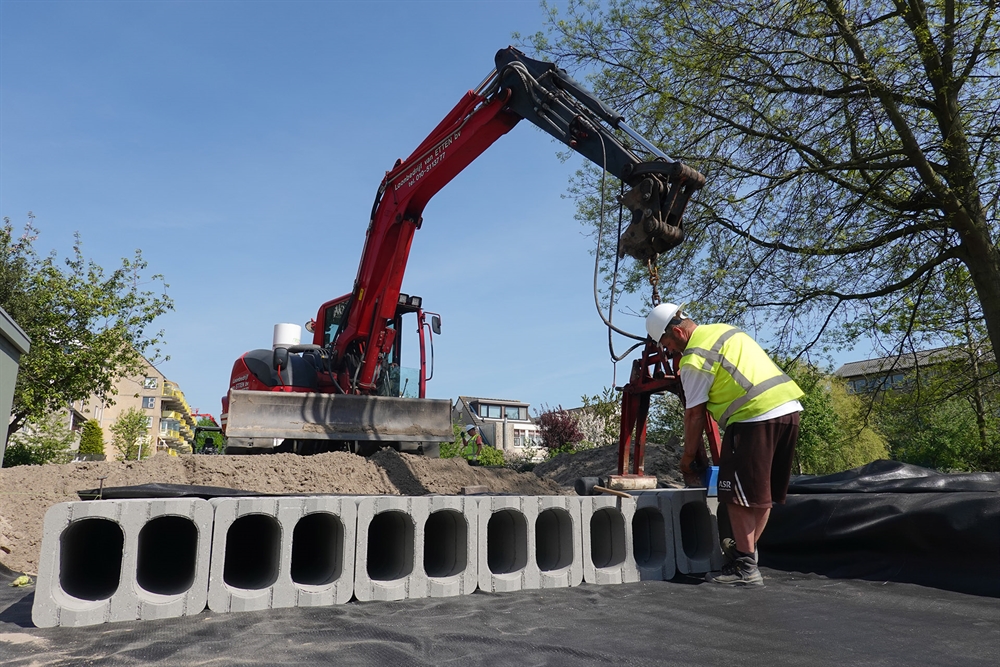Capelle aan den IJssel has launched project to combat soil subsidence and waterlogging
The municipality of Capelle aan den IJssel is climate-proofing Arica Street in the Middelwatering neighbourhood by means of the WaterWeg project. During extreme rainfall, high groundwater levels can cause waterlogging. Conversely, during periods of drought, the area is prone to soil subsidence. To prevent this, the municipality is constructing water storage facilities and greening the street. Some measures are being implemented underground, others will be manifest in the street.
What was the reason for launching the WaterWeg project?
As the sewers in Arica Street were due for replacement, the municipality scheduled a major maintenance project and seized the opportunity to climate-proof the street as well. Because water plays a pivotal role, the project was named WaterWeg [Dutch word play: Weg translates as both “away” and “road”].
What does the WaterWeg project entail?
In the WaterWeg project, the municipal authorities are combining major repairs to the street with climate adaptation measures. Sewers and public greenery are being replaced, and the street is being raised. Concurrently, the authorities have commissioned six measures to store and infiltrate water into the soil:
- Water-storing road foundation
- Natural water storage
- Cesspool-free street
- Green-blue street
- Green parking and green road
- Stairs
Water-storing road foundation
Underneath the street, two types of foundations will be constructed that are capable of storing water:
- Buffer Blocks. Buffer Blocks are large concrete blocks featuring a hollow space. The concrete blocks are capable of collecting thousands of litres of water. The WaterWeg project will see the first application of the Buffer Blocks.
- Lava stones. Lava is released when a volcano erupts. During its solidification, the lava forms air bubbles. As a result, lava stones are capable of storing a great deal of water.
The Buffer Blocks and the lava stones gradually drain the water into the soil. This reduces the probability of waterlogging during severe rainfall. The soil will stay moist and be less prone to subsidence.

Natural water storage
The municipal authorities have also commissioned the construction of a natural water storage facility. This lower-level green spot is also referred to as a wadi. When it rains, blue gutters will transport local water to the natural water storage. White arrows indicate the direction in which the water will flow. The visible flow of water through the street will raise residents’ awareness of water. Subsequently, the water will slowly infiltrate into the soil. The water storage reduces the probability of waterlogging and enhances biodiversity.
Video: Michael Afanasyev, Misea Consultancy
Cesspool-free street
A section of the street will have no cesspools. This means that rather than wells to drain rainwater, blue gutters will transport the water to the nearby ditch. As with the natural water storage, this will raise water awareness in the street. Drainage tiles will discharge the water falling on rooftops to the street. This measure prevents rainwater from ending up in the sewer.
Green-blue street
In a section of the street, the middle part will be greened. If need be, traffic can travel across the greenery in a type of cart track. This gives the street a green feel and allows rainwater to infiltrate into the soil.
Green parking and green road
The street will have green parking spaces: parking spaces paved with stones in which grass grows. This gives a greener appearance and allows water to infiltrate between the stones into the soil. A section of the street will also be paved with such stones, thus creating a green road.
Stairs
Part of Arica Street is located next to the Hollandse IJssel dyke. Three stairs connect the street with the dyke. The municipal authorities are replacing the stairs, giving each its own theme:
- The dyke stairs. These concrete stairs show that the street is located below sea level. Several water levels are indicated on the stairs: high water, low water, and the water level during the 1953 storm surge. The stairs thus demonstrate how the dyke is protecting the street from flooding. This image is reinforced by the basalt blocks and sheet pile walls near the stairs.
- The green stairs. Only part of these stairs is concrete, the rest of the stairs is green. The greenery keeps the stairs cool and allows rainwater to infiltrate into the soil.
- The water stairs. Along these stairs, rainwater flows down, whilst passers-by keep their feet dry.
What is the experience with WaterWeg?
As yet, the project measures have generated positive experiences:
- There have been two severe downpours, neither of which has caused waterlogging;
- The water flowing to the natural water storage via the blue gutters will infiltrate into the soil within 24 hours;
- Placing the Buffer Blocks has turned out easier than expected. The municipal authorities do not yet know exactly how effective they are. As this is the first location at which the blocks have been used, their performance cannot yet be compared to the performance of such blocks elsewhere;
- By keeping the soil moist, the authorities hope to combat subsidence, thus also reducing the probability of sagging. The municipality will monitor the effectiveness of this measure.
The municipality can use the experience gained with the WaterWeg project for other locations and streets. As the municipality is participating in the European STAR2Cs project, it will also be of benefit to municipalities in other countries.
What is STAR2Cs?
STAR2Cs is a project in which European municipalities share their experience on climate adaptation. The participating municipalities are situated in the United Kingdom, France, Belgium, and the Netherlands. The project is aimed at enabling participants to learn from one another. The municipalities exchange experience with measures and ways to involve residents and businesses when drawing up adaptation plans. In addition, the project addresses ways to utilise initiatives and ideas put forward by residents and organisations. STAR2Cs has contributed financially to the development of WaterWeg.
Contact person
Dirk van den Heuvel
Gemeente Capelle aan den IJssel
d.van.den.heuvel@capelleaandenijssel.nl
